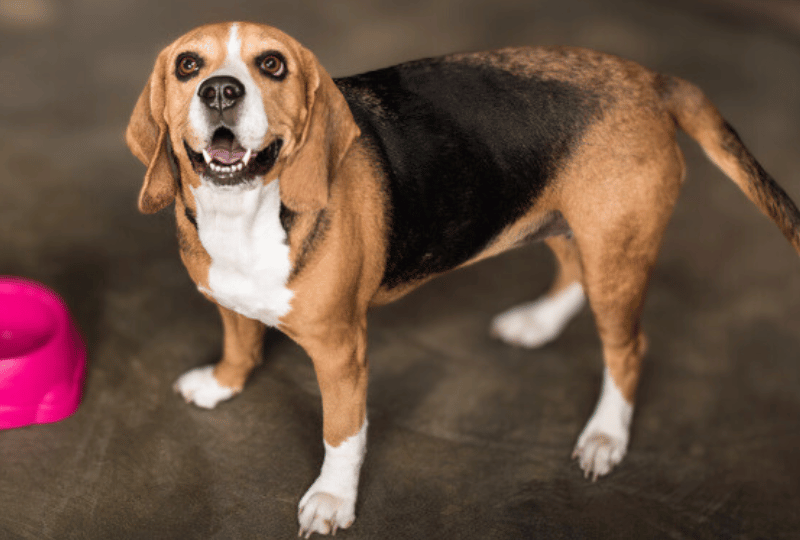When it comes to food, I feel like I have encountered two kinds of dogs: the ones that barely eat and you have to chase them down with the most tempting delicacies, and the ones that never seem full and eat everything in sight, even if it is not edible.
If you have a dog that loves food to the point that you have to keep your counters clear and hide your garbage, it might seem like they are never full. But then if you have a dog that free-feeds (meaning they always have food available rather than scheduled feedings), you might observe that your dog knows when to stop eating. So what’s going on here and why does it seem like there’s never enough food for some dog?!
Veterinarian and Not A Bully advisor Nita Patel explains that “Dogs do get full, but because they are descended from scavengers, they do not always want to stop eating.
Even though your pampered pup has gotten two square meals a day every day of their life, their instincts might tell them that they need to keep eating in case of future famine. This is especially true if they are sharing food or space with other dogs or animals in the house as they may feel they are competing for a common food source.
Some dogs will overeat to the point of sickness, including nausea, vomiting, or bloating. Besides instinct, dogs may be motivated by other factors like age, activity level, personality, and breed.”
In this article we will discuss that dogs do usually feel full, but why they often tend to eat past fullness and do not seem to know when to stop eating. We’ll also discuss reasons why your dog not getting full might not be a personality trait but could be a sign of a health issue.
Do Dogs Know When To Stop Eating?
While dogs might get full, some dogs do not always know when to stop eating. Evolutionary, dogs are scavengers. They are descended from wolves that picked off leftover bones and trash around early human settlements.
When eating, some have trouble separating the idea that they receive regular nutritious meals from the instinctual need to scarf down everything in sight so they do not go hungry later.
Depending on their background, if you have a rescue dog, they might have a history of not knowing where they would get their next meal.
Furthermore, because of their evolution as opportunistic eaters, dogs can consume and hold a lot more food in their stomachs. Their digestion system makes extra room by relaxing certain muscles in the stomach.
So while your dog feels full and has gotten two square meals every day of their pampered life, they might feel like they need to keep eating in case of future famine.
Owners of certain breeds like Labradors, Golden Retrievers, and Beagles find that their dogs always are looking for more treats.
Like humans, who always seem to find room for dessert, even the pickiest eaters can make room for extra treats!
Do any of these begging dogs remind you of your own dog when they want treats?
Genetics And Dogs Feeling Full
Certain dog breeds are known for being picky. They might have too high a working drive to want to eat, anxiety, or sensitive stomachs.
However, I think the majority of dog owners have experienced having a chow hound over a picky eater. It is almost like these dogs are wired to eat themselves to obesity.
As a dog trainer, there are certain dogs we call “walking stomachs,” Labrador Retrievers seem to be the biggest culprit.
One study suggests that Labrador Retrievers might have a mutation in their gene sequence that makes them more prone to overeating and being overweight.
So if you feel like your dog never feels full and wants to eat themselves to death, it might be genetic!
Will Dogs Eat Themselves To Death?
While there are dogs that will stop eating when they are full, many dogs will eat themselves sick. The problem with dogs eating too much in a single period is that your dog can bloat.
Bloating, or Gastric Dilatation-Volvulus (GDV), is a serious condition that occurs when your dog eats too much food way too fast, especially when paired with exercise close to the meal.
If your dog is suffering from GDV, they have a twisted stomach and too much air. It is a serious condition and you should seek immediate veterinary care if you are worried your dog has GDV. It can be deadly.
Besides gas and the physical expansion of your dog’s stomach, other symptoms of GDV include:
- Swollen and painful abdomen
- Pacing and restlessness
- Being distressed
- Inability to vomit
- Drooling
- Panting
- Not able to stand
Any dog can get GDV if they eat too fast or eat too much, but it is much more serious for bigger dogs with deep barreled chests. Remember, many dogs will keep trying to eat once they are full.
To prevent GDV, do not let your dog overeat or exercise heavily around meal times. If your dog develops bad habits like getting into the trash, it is important to manage those behaviors for your dog’s safety.
If your dog wolfs down their food too fast, please consider feeding them in a puzzle feeder to help them slow down!
Obesity In Dogs
According to veterinarians Malcolm Weir, Krista Williams, and Robin Downing, “In North America, obesity is the most common preventable disease in dogs” affecting up to 50% of canines.
Obesity is simply excess body fat, caused by a combination of overeating and not enough exercise. And it can increase your dog’s risk for certain health risks like diabetes, cancer, or heart disease.
So while dogs can feel full, they still like to overeat. It stems from a survival mechanism, but if your dog gets two meals a day they probably do not need to gorge themselves like their scavenger ancestors use to.
If you are worried your dog is overweight, here is a helpful video to help you understand what obesity looks like in dogs.
Feeding A Dog That Does Not Know When To Stop Eating
If you have a dog that loves food, they will not want to eat one meal a day or be able to be free-fed.
Instead of free-feeding (leaving out a bowl of food all day) dogs that eat past the point of fullness will need two scheduled, portioned, nutritious meals a day.
Your dog’s calorie needs depend on their exercise level, age, and breed. For example, a young high-energy husky is going to need a more protein-rich meal than a low-energy lapdog like a chihuahua.
This handy scientific guide can help you determine the best way to feed your dog to make sure they are getting the correct amount of calories.
If your dog needs to lose weight, there are lots of choices out there for lower-calorie dog food. Avoid giving your dog too many table scraps like deli meat, as the sodium and nitrate levels can be too high for your dog’s body to process.
Opt for low-calorie and high-fiber treats like low-sodium green beans, carrots, or pumpkin. If you want to help your dog feel more full after eating, think about adding these filler treats to your dog’s meal.
Should I Be Worried?
Some dogs do not seem to not realize they are full and do not know when to stop eating and usually loving food is not a bad thing. Usually, it is just a quirky personality trait!
However, an uncontrollable appetite and the inability to get full can be a symptom of something more serious, especially if paired with the inability to keep weight on.
Pica
A dog with Pica wants to eat nonfood items, sometimes one nonfood item or multiple things. Most dogs understand what is and is not food, but dogs with Pica might get into paper, towels, batteries, or even rocks. Their behavior can be frustrating and worrisome.
While diagnosing Pica as a behavior is easy, the underlying reason for the problem could be a trickier investigation.
Malnutrition, diabetes, or hormonal imbalances could all be reasons why your dog tries to eat nonfood items and never seems full. Your veterinarian can help you diagnose whatever is causing your dog’s Pica.
I have a dog that has developed Pica from his anti-seizure medications. He never seems full and I have to manage the behavior by keeping things he likes to eat (like cloth and paper) off the floor and keeping a close eye on him outside.
Malabsorption
Increased appetite, horrible diarrhea, and the inability to keep weight on are all symptoms of malabsorption.
While it can be hard to pinpoint the reason your dog cannot get full or keep on weight, veterinarians have found success with treating the issue with long-term antibiotics.
Hypothyroidism
Like malabsorption, a dog who is suffering from hypothyroidism will eat like they cannot get full but still experience weight loss.
Other symptoms include diarrhea and vomiting, and it can even lead to congestive heart failure.
A veterinarian can diagnose this and help set up a treatment plan.
Diabetes
Early symptoms of canine diabetes include eating like they cannot get full and weight loss. Other early symptoms include uncontrollable thirst and excessive urination.
However, increased appetite can turn into no appetite if left untreated.
There are different kinds of diabetes that a dog can be diagnosed with and a veterinarian will find the best treatment for your dog.
Cushing’s Disease
Usually affecting older dogs, Cushing’s Disease is a hormonal issue where the body produces too much cortisol.
The biggest red flag is losing hair and decreased energy, but you might also see your dog not able to stop eating while still losing weight.
Cushing’s is an autoimmune disease, so if you suspect your dog has Cushing’s, please go see your veterinarian to start treatment. They will be a lot more susceptible to other infections and diseases!
Final Thoughts
Part of the responsibility of dog ownership is making sure your canine best friend’s nutritional needs are met. This means finding the best food for your dog and making sure they get the correct portions.
Because of the instinctual desire to scavenge, a lot of dogs will eat past the point of fullness and not know when to stop eating. It can be hard, but dog owners have to ignore the begging puppy eyes.
Obesity is a common problem in the pet dog population, and we have to manage to insure that our dogs get the correct amount of food and do not trick us into feeding them extra food and treats.
If your dog does not know how to stop eating after they feel full, you will have to be extra careful about feeding them the correct amount of food so they do not become overweight.
Overweight dogs are prone to many health concerns which can limit what you can do with your dog.
Keeping your dog at an appropriate weight will keep them healthier into old age so you can have many more adventures with them!


